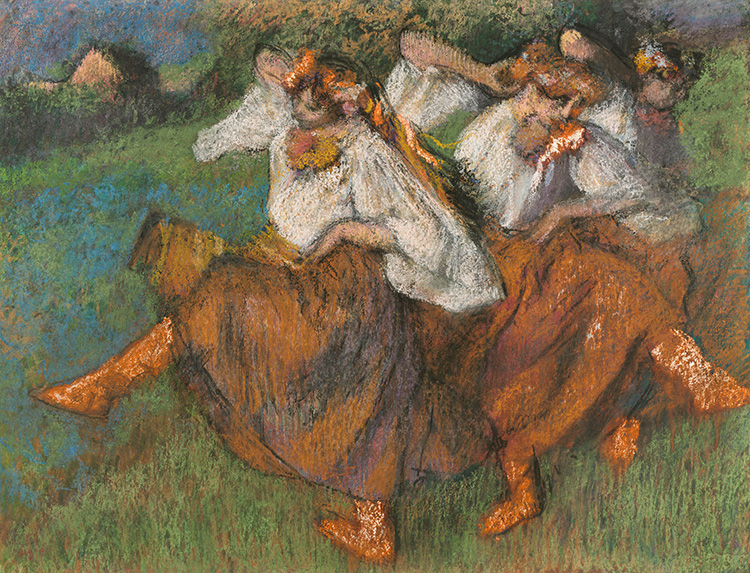Editor’s Note: This artwork, on loan to Getty in 2016, was titled by Degas Russian Dancers. However, they are more accurately described as Ukrainian. Degas likely saw Ukrainian performers in Paris.

Russian Dancers, 1899, Edgar Degas. Pastel and brush on tracing paper, 22 7/16 × 29 1/2 in. Courtesy of a private collection
When looking at the pastel Russian Dancers by Edgar Degas, currently on loan to the J. Paul Getty Museum from a private collection, the vibrant colors and dynamic technique impart the illusion of actually listening to music while seeing the figures in motion. The young women, dressed in traditional costumes with colorful ribbons in their hair, explode off the composition, dancing with a sense of abandon. Their voluminous skirts and sleeves swirl, and arms and legs fly through the air, all to the beat of a pounding rhythm.
This extraordinary masterpiece belongs to a series of pastels and drawings depicting Russian or, more accurately, Ukrainian folk dancers executed by Degas, the artist most associated with depictions of ballet, in the late 19th century.
Foreign Dancers
Degas probably saw Ukrainian dancers in Paris, where they performed in cabarets and theaters. Such ethnic troupes were a popular attraction, given the French interest in Eastern European traditions after the establishment of the Dual Alliance between France and Russia in 1894.
Despite the uniqueness of Ukrainian culture, the dancers were generically called “Russian dancers,” because the majority of Ukraine was still part of the Russian Empire at the time. Moreover, Tsar Alexander II, who reigned from 1851 to 1881, carried out a policy of Russification throughout the empire, forcing non-Russian communities to give up their culture and language in favor of Russian practices.
While classical ballet had always fascinated Degas, in this pastel he turned his attention to a more exotic form of performance art, one that embodies the primal human impulse to dance. These exuberant dancers contrast strongly with the ethereal ballerinas of the artist’s earlier paintings. Degas called his Russian dancers his “orgies of color.”

Detail of Russian Dancers showing Degas’s colorful, richly layered pastels. Courtesy of a private collection
The Pastel Revival
Beginning with charcoal sketches, Degas achieved rich textures in this series by applying alternate layers of pastel and fixative. Using tracing paper, he transferred and reused figures from other drawings, combining individual dancers in different compositions. Degas did not merely produce duplicates; he copied whole figures but also selected portions, changing contours and adding other details. Examples of these interrelated pastels are in collections of the Metropolitan Museum of Art in New York, the National Gallery in London, and the Museum of Fine Arts, Houston.
In all of these pastels, the immediacy of drawing is supremely combined with the vibrancy of painting.
At the J. Paul Getty Museum, Russian Dancers is displayed through October 23, 2016, with a selection of artworks from the permanent and private collections, including Camille Pisarro’s Landscape with Thresher at Montfocault (1875), Alfred Sisley’s Cows in the Pasture (1874), Édouard Manet’s Portrait of Julien de la Rochenoire (1882), and Odilon Redon’s Baronne de Domecy (c. 1900). Degas and these artists masterfully revived the 18th-century tradition of pastel, enlivening it in the 19th century.




Comments on this post are now closed.